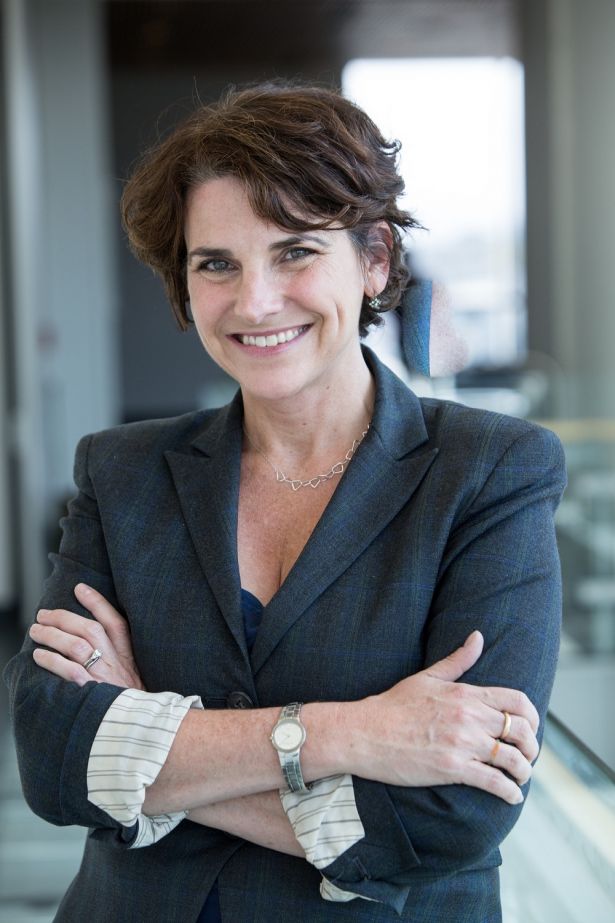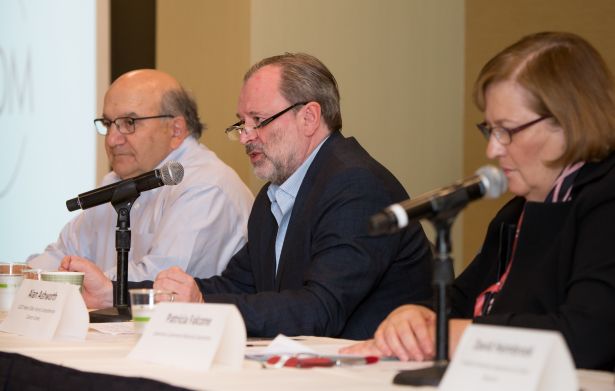- About
- Organization
- Organization Overview
- Dean’s Office
- Department of Bioengineering and Therapeutic Sciences
- Department of Clinical Pharmacy
- Department of Pharmaceutical Chemistry
- Quantitative Biosciences Institute
- Org Chart
- Research
- Education
- Patient Care
- People
- News
- Events
UCSF School of Pharmacy joins data-sharing partnership to speed cancer drugs
By Levi Gadye / Thu Nov 2, 2017

A supercomputer in the Lawrence Livermore National Laboratory will be used in Project ATOM, a new public-private project that aims to speed discovery of new drug therapies.
Science sometimes feels like a marathon—a long race to a big finish, like a cover story in a top-tier journal or FDA approval of a new drug.
Now, a pioneering public/private consortium is poised to turn the marathon of drug discovery into a team relay, maybe even a short one, hopefully something closer to a 400-meter dash.
Aiming to shake up how drug discovery is done, UC San Francisco and its School of Pharmacy have joined forces with the U.S. Department of Energy’s Lawrence Livermore National Laboratory (LLNL), the National Cancer Institute’s Frederick National Laboratory for Cancer Research (FNLCR), and the pharmaceutical company GlaxoSmithKline (GSK).
On October 27, they unveiled a collaboration that intends to streamline the translation of scientific discovery into medical breakthroughs.
Accelerating discovery, from six years to one
Project ATOM (Accelerating Therapeutics for Opportunities in Medicine) has its sights set on the six years that are normally required to shepherd new drug candidates into clinical trials. Project ATOM will try to do it in just one year, using cancer as its first therapeutic target. The project will use data, contributed by GSK, on millions of tested molecules, including hundreds of potential drugs that come along with clinical data on metabolism, side effects, and other biological interactions.
“The question we began to ask ourselves in 2015 was: ‘Is there a better way of doing drug discovery?’” said John Baldoni, senior vice president of research and development at GSK, at the press announcement of the project last Friday in downtown San Francisco. “At that point, we had come to the conclusion that there were emerging sciences and technologies that could enable us to do drug discovery in a different way—with higher velocity, more precision, and much lower costs.”
Like other pharmaceutical companies, GSK sifts through millions of potentially therapeutic molecules to find a few hundred that advance to laboratory testing. Finally, handfuls of candidate molecules are subjected to clinical trials. If a molecule fails any of those steps, the results are never published.
Finding success in ‘dark data’
“Buried in pharma companies is what I call the dark data, the data of the failed compounds, data on compounds that those companies are no longer interested in,” Baldoni said. “We want to reveal that dark data to become more effective at drug discovery and development.”

Michelle Arkin, PhD, is UCSF’s representative to Project ATOM. She is co-director of the Small Molecule Discovery Center (SMDC), and a faculty member in the UCSF School of Pharmacy, Department of Pharmaceutical Chemistry.
ATOM is the first example of a major company turning over unpublished data, with few strings attached, to drive machine learning approaches for drug discovery.
“This is quite an unusual opportunity to get a broader sense of what hasn't worked, and why it hasn't worked,” said Michelle Arkin, PhD, co-director of the Small Molecule Discovery Center (SMDC) in the UCSF School of Pharmacy, and the university’s representative to Project ATOM. “At early stages [of the drug discovery pipeline], you're not really selecting ‘for’ as much as you are selecting ‘away,’ until you get down to a small number of molecules that you can look at really carefully.”
A unique partnership
Beyond leveraging GSK’s data to speed drug discovery, Project ATOM also promises to forge new relationships between scientists in industry, government, and at UCSF. “The idea is to have an integrated and intimate collaboration among these centers,” said Arkin.
B. Joseph Guglielmo, PharmD, dean of the UCSF School of Pharmacy, said that the School’s long history of industry-changing collaborations and recent virtual drug screening efforts make it an ideal partner. “We have a very long track record in the collaborative discovery of new drugs across all therapeutic domains,” Guglielmo said. “ATOM is absolutely consistent with our strengths as scientists and partners.”

An ATOM press briefing in San Francisco on October 27 included (left to right) John Baldoni, PhD, senior vice president of research and development at GlaxoSmithKline; Alan Ashworth, PhD, president of the UCSF Helen Diller Comprehensive Cancer Center; and Patricia Falcone, PhD, deputy director of the Lawrence Livermore National Laboratory.
Importantly, the consortium is open, designed to encourage other pharmaceutical companies and research institutions to contribute resources and provide additional fuel for new approaches for drug discovery.
“Project ATOM has the potential to transform how drugs are discovered and developed in our industry and I can't imagine a better group of people to tackle the problem than the consortium that we've assembled thus far,” said Harold E. “Barry” Selick, PhD, UCSF vice chancellor of innovation and partnerships, who is serving Project ATOM in an advisory role. “With that said, we do need more data, and we need more expertise.”
More
Public-Private Consortium Aims to Cut Preclinical Cancer Drug Discovery from Six Years to Just One
Tags
Keywords:
Category:
Sites:
School of Pharmacy, Department of Pharmaceutical Chemistry, PharmD Degree Program, CCB, Bioinformatics, Biophysics, BMI
About the School: The UCSF School of Pharmacy aims to solve the most pressing health care problems and strives to ensure that each patient receives the safest, most effective treatments. Our discoveries seed the development of novel therapies, and our researchers consistently lead the nation in NIH funding. The School’s doctor of pharmacy (PharmD) degree program, with its unique emphasis on scientific thinking, prepares students to be critical thinkers and leaders in their field.




